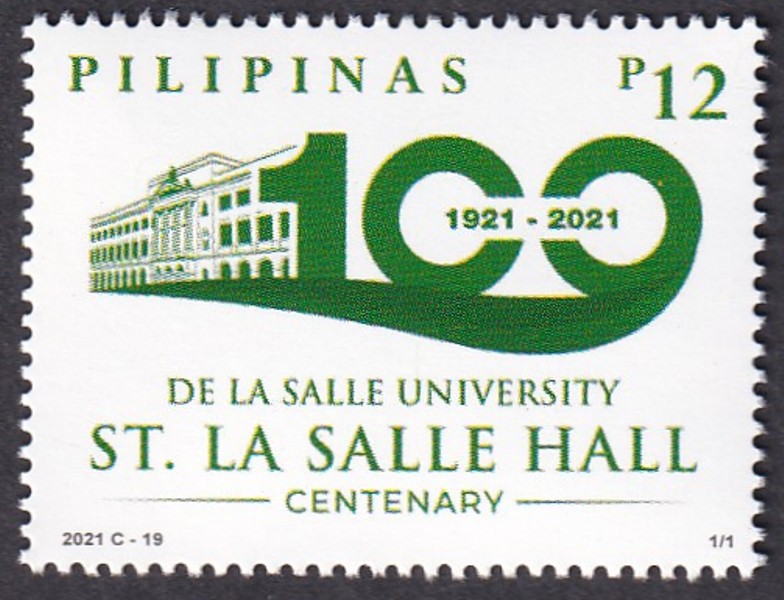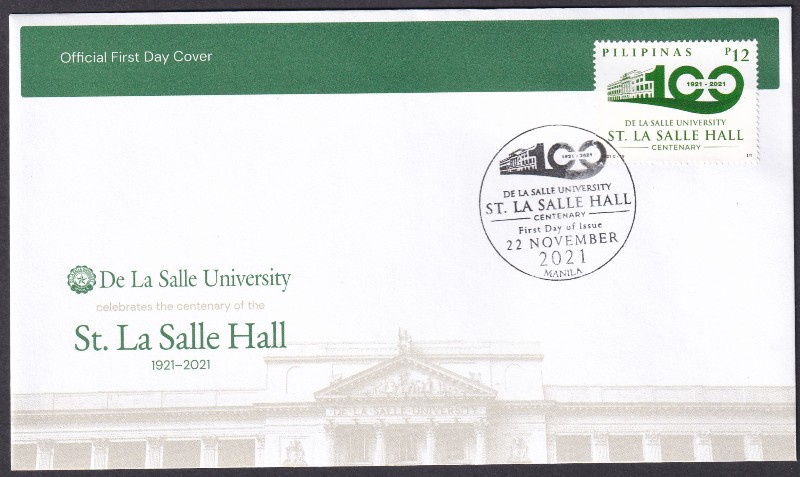2021, November 22. De La Salle University - St. La Salle Hall Centenary
Litho Offset, Amstar Printing Company, Inc., Perf 14
Singles, Sheets of 40

12p - De La Salle University - St. La Salle Hall - Singles (40,000)
Layout Artist: Eunice Beatrix U. Dabu
Design: De La Salle University (DLSU)
Coordinator: Jocelyn E. Cacho
Researcher/Writer: Maria Abigail D. Tarrova
First Day Covers: Manila
DE LA SALLE UNIVERSITY - ST. LA SALLE HALL CENTENARY
The Philippine Postal Corporation (Post Office) issues stamps and official first day covers for “De La Salle University – St. La Salle Hall Centenary (1921-2021)”, to commemorate the 100th anniversary of the first classes held in St. La Salle Hall of its Manila Campus.
The De La Salle University in the Philippines was established on June 16, 1911, by the Catholic teaching congregation, Fratres Scholarum Christianarum (est. 1680), or Brothers of the Christian Schools. The organization had been founded in 1680 as a community of consecrated laymen by St. Jean-Baptiste La Salle whose vision of teachers were those who “teach minds, touch hearts, and transform lives”. Thus the first La Salle school in the Philippines was opened by the Brothers in Paco, outside the old city of Manila, under the urging of the American Archbishop of Manila for them to pave the way to introduce English-based quality Catholic education in the country. In 1912 it was incorporated as the De La Salle College (DLSC), and the institution from then would grow to serve a greater number of students. As the DLSC and its reputation for excellence in business education escalated, its enrollees increased as well, and in 1921, the DLSC moved from the Nozaleda campus (currently General Luna St.) to its present location. The first classes were held in the neoclassical St. La Salle Hall, designed by Filipino architect, Tomas Mapua, on October 3, 1921. The hall would be finished in 1924, and the architect’s design was fully realized with the completion of the north wing in 1938.
The DLSC was allowed to remain open for much of World War II. It absorbed students from schools that had closed, even while Japanese forces occupied part of the campus. The massacre of 16 brothers and 25 other residents on February 1, 1945, during the Liberation of Manila forced its closure. The college, with the rest of the devastated city, embarked on redevelopment. Rebuilding a nation requires a populace ready and prepared, thus the college reopened with improved programs and offered courses on new fields. Responding to changing times and the emergence of the Women’s Liberation Movement, the college held its first Student Council Elections in 1969, and in 1973, started accepting female enrollees. The college was granted university status on February 19, 1975. Since then, it has been known as De La Salle University (DLSU).
The DLSU began its bid to become a research university in the 1990s, growing its research output to do so. As its centennial year drew near, the Philippine Lasallian community framed the Lasallian Guiding Principles (LGP) in 2003 which directed the subsequent framing and institution of the Lasallian Pedagogical Framework (LPF) and the Lasallian Core Curriculum (LCC) in 2004. In 2008, these were applied in the formulation of the Expected Lasallian Graduate Attributes (ELGAs). The University established its College of Law in 2009 to play a critical role and to contribute to human rights advocacy in Philippine society. DLSU elevated its Economics Department into the School of Economics to give the institution’s well-regarded arm more leverage on influencing national policy development.
The heritage of the DLSU and its legacy of excellence in education is recognized through stamps and official first day covers featuring the profile of the iconic St. La Salle Hall, with the years “1921-2021” highlighted along with the name of the esteemed institution. The easily recognizable pediment and façade of the iconic building decorates the official first day cover. The philatelic items bear the official colors of the university, which after a hundred years, continues to be inspired by the charism of its founder, aspires to be a leading learner-centered research university, and commits itself to bridging faith and scholarship in the service of society, especially the poor.
-
Schools & Universities
